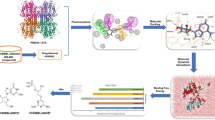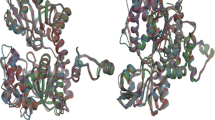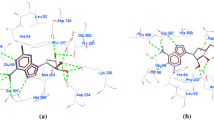Abstract
S-adenosyl-l-homocysteine hydrolase (SAHH) is a ubiquitous enzyme that plays a significant role in methylation-based processes by maintaining the intracellular balance between S-adenosylhomocysteine and S-adenosylmethionine. In the past years, some analogs and derivatives of aristeromycin have been reported as a potential inhibitor of Plasmodium falciparum’s SAHH (PfSAHH), but no effective therapy has been developed yet. In our previous studies, molecular dynamics simulation study of 2-fluoroaristeromycin in complex with PfSAHH was carried out, and a stable complex with favorable binding energy and interaction was observed. In the presented work, 2-fluoroaristeromycin was used as a central compound for finding the vast set of similar compounds using PubChem database search (65 compounds), pharmacophore-based search (1219 compounds) and ZINC database search for biogenic compounds (approximately 1, 82000 compounds). All these compounds were docked with PfSAHH drug target to screen compounds with energetically favorable binding and stable conformation. Binding energy and different ADMET based parameters were used for screening some potential compound from each set. Binding affinity and interaction of top scoring 15 compounds from the biogenic subset were again evaluated using other docking tools such as AutoDock and AutoDock Vina. These top scoring compounds satisfy the binding and most of the ADMET parameters, and their activity can be further optimized to find a more potent inhibitor of PfSAHH.






Similar content being viewed by others
References
Beck HP, Wampfler R, Carter N, Koh G, Osorio L, Rueangweerayut R (2016) Estimation of tafenoquine anti-relapse efficacy using Plasmodium vivax genotyping. J Infect Dis 213:794–799
Burrows JN, Duparc S, Gutteridge WE, Hooft van Huijsduijnen R, Kaszubska W, Macintyre F, Mazzuri S, Möhrle JJ, Wells TNC (2017) New developments in anti-malarial target candidate and product profiles. Malar J 16(1):26
Cheng F, Li W, Zhou Y, Shen J, Wu Z, Liu G, Lee PW, Tang Y (2012) admetSAR: a comprehensive source and free tool for assessment of chemical ADMET properties. J Chem Inf Model 52:3099–3105
Gaulton A, Bellis LJ, Bento AP, Chambers J, Davies M, Hersey A, Overington JP (2012) ChEMBL: a large-scale bioactivity database for drug discovery. Nucleic Acids Res 40(Database issue):D1100–D1107
Irwin JJ, Sterling T, Mysinger MM, Bolstad ES, Coleman RG (2012) ZINC: a free tool to discover chemistry for biology. J Chem Inf Model 52:1757–1768
Kitade Y, Kojima H, Zulfiqur F, Kim HS, Wataya Y (2003) Synthesis of 2-fluoronoraristeromycin and its inhibitory activity against Plasmodium falciparum S-adenosyl-l-homocysteine hydrolase. Bioorg Med Chem Lett 13:3963–3965
Koes DR, Camacho CJ (2012) ZINCPharmer: pharmacophore search of the ZINC database. Nucleic Acids Res 40:W409–W414
Kojima H, Yamaguchi T, Kozaki A, Nakanishi M, Ueno Y, Kitade Y (2002) Synthesis of noraristeromycin analogues possessing SAH hydrolase inhibitory activity for the development of antimalaria agents. Nucleic Acids Res Suppl 2:141–142
Kusakabe Y, Ishihara M, Umeda T, Kuroda D, Nakanishi M, Kitade Y, Gouda H, Nakamura KT, Tanaka N (2015) Structural insights into the reaction mechanism of S-adenosyl-l-homocysteine hydrolase. Sci Rep 5:16641
Morris GM, Huey R, Lindstrom W, Sanner MF, Belew RK, Goodsell DS, Olson AJ (2009) AutoDock4 and AutoDockTools4: automated docking with selective receptor flexibility. J Comput Chem 30:2785–2791
Phillips T (2008) The role of methylation in gene expression. Nat Educ 1:116
Reddy MC, Kuppan G, Shetty ND, Owen JL, Ioerger TR, Sacchettini JC (2008) Crystal structures of Mycobacterium tuberculosis S-adenosyl-l-homocysteine hydrolase in ternary complex with substrate and inhibitors. Protein Sci 17:2134–2144
Rosling JEO, Ridgway MC, Summers RL, Kirk K, Lehane AM (2018) Biochemical characterization and chemical inhibition of PfATP4-associated Na(+)-ATPase activity in Plasmodium falciparum membranes. J Biol Chem 293:13327–13337
Singh DB (2018) Natural lead compounds and strategies for optimization. In: Ul-Haq Z, Wilson AK (eds) Frontiers in computational chemistry, vol 4. Bentham science, pp 1–47
Singh DB, Dwivedi S (2016a) Structural insight into binding mode of inhibitor with SAHH of Plasmodium and human: interaction of curcumin with anti-malarial drug targets. J Chem Biol 9:107–120
Singh DB, Dwivedi S (2016b) Docking and molecular dynamics simulation study of inhibitor 2-Fluoroaristeromycin with anti-malarial drug target PfSAHH. Netw Model Anal Health Inf Bioinf 5:16
Singh DB, Gupta MK, Singh DV, Singh SK, Misra K (2013) Docking and in silico ADMET studies of noraristeromycin, curcumin and its derivatives with Plasmodium falciparum SAH hydrolase: a molecular drug target against malaria. Interdiscip Sci 5:1–12
Talsania N, Modi K, Chaudhary P (2012) A Study of investigation report on death audit due to malaria in New Civil Hospital, Ahmedabad City, Gujarat, India. Healthline 3:26–29
Thomsen R, Christensen MH (2006) MolDock: a new technique for high-accuracy molecular docking. J Med Chem 49:3315–3321
Trott O, Olson AJ (2010) AutoDock vina: improving the speed and accuracy of docking with a new scoring function, efficient optimization and multithreading. J Comput Chem 31:455–461
Van de Waterbeemd H, Gifford E (2003) ADMET in silico modelling: towards prediction paradise? Nat Rev Drug Discov 2:192–204
Verma P, Singh DB, Gupta AK (2016) Designing and virtual screening of potential inhibitors of PFHGPRT against malaria. J Chem Pharm Res 8:635–643
Wells TNC, Hooft van Huijsduijnen R, Van Voorhis WC (2015) Malaria medicines: a glass half full? Nat Rev Drug Discov 14:424–442
White NJ, Pukrittayakamee S, Phyo AP, Rueangweerayut R, Nosten F, Jittamala P (2014) Spiroindolone KAE609 for falciparum and vivax malaria. N Engl J Med 371:403–410
Yang SY (2010) Pharmacophore modeling and applications in drug discovery: challenges and recent advances. Drug Discov Today 15:444–450
Author information
Authors and Affiliations
Corresponding author
Ethics declarations
Conflict of interest
All authors declare that they have no conflict of interest.
Additional information
Publisher’s Note
Springer Nature remains neutral with regard to jurisdictional claims in published maps and institutional affiliations.
Electronic supplementary material
Below is the link to the electronic supplementary material.
Rights and permissions
About this article
Cite this article
Singh, D.B., Dwivedi, S. Computational screening and ADMET-based study for targeting Plasmodium S-adenosyl-l-homocysteine hydrolase: top scoring inhibitors. Netw Model Anal Health Inform Bioinforma 8, 4 (2019). https://doi.org/10.1007/s13721-019-0183-7
Received:
Revised:
Accepted:
Published:
DOI: https://doi.org/10.1007/s13721-019-0183-7




